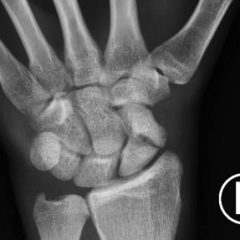Type 1 Brugada Syndrome
History of present illness:
A 56-year-old male, with a history of hypertension, diabetes, and dyslipidemia, presented with chest pain, fever, and abdominal pain associated with diarrhea, one day post colonoscopy, for which an electrocardiogram (ECG) was done. On further review of history, the patient reported a syncopal episode 2 monthprior. Additionally, he reports a brother who died of sudden cardiac death (SCD) at the age 50.
Significant findings:
ECG shows an incomplete right bundle branch block (blue arrow) with coved ST segment elevation and an inverted T wave in V1 (red arrow) and ST segment elevation in V2 (black arrow).
Discussion:
Brugada syndrome is a rare autosomal dominant disease with mutations in the cardiac sodium channel. It is highly associated with ventricular fibrillation and sudden cardiac death (SCD) in predominately middle-aged males.1 The diagnosis is based on a particular ECG pattern described by the Brugada brothers in 1992.2 There are 3 types of Brugada patterns. Our patient’s ECG was consistent with type 1, which is diagnostic and is characterized by a coved ST segment elevation greater than 2mm followed by a negative T wave in the precordial leads.3 Other types include type 2, which shows a saddle-back ST segment elevation with a J-wave greater than 2mm followed by a positive or biphasic T wave, and type 3, which shows ST elevation less than 2 mm in either coved or saddle-back type T wave.4
Patients with Brugada syndrome often present with syncope, non-sustained ventricular tachycardia, atrial fibrillation, or SCD, with a family history of similar episodes. The presence of fever, alcohol intake, sodium channel blockers, cocaine use, and electrolyte imbalances can significantly increase the incidence of arrhythmia.1 The risk of cardiac events in patients with type 1 Brugada and syncope is 1.9% per year and 7.7% per year in those with aborted SCD.3 An implantable cardiac defibrillator (ICD) is the main treatment for symptomatic patients. Those who are asymptomatic or those with type 2 or 3 morphology should undergo further genetic testing and risk stratification for ICD placement.1
Our patient had a negative cardiac catheterization but with his ECG pattern along with his history of syncope and family history of SCD, he was diagnosed with type 1 Brugada syndrome and received an ICD.
Topics:
EKG, ECG, cardiology, Brugada, arrhythmia.
References:
- Gourraud JB, Barc J, Thollet A, Le Marec H, Probst V. Brugada syndrome: diagnosis, risk stratification and management. Arch of Cardiovasc Dis. 2017;110(3):188-195. doi: 10.1016/j.acvd.2016.09.009
- Brugada P, Brugada J. Right bundle branch block, persistent ST segment elevation and sudden cardiac death: a distinct clinical and electrocardiographic syndrome. A multicenter report. J Am Coll Cardiol. 1992;20(6):1391-1396.
- Antzelevitch C, Patocskai B. Brugada syndrome: clinical, genetic, molecular, cellular, and ionic aspects. Curr Probl Cardiol. 2016;41(1):7-57. doi: 10.1016/j.cpcardiol.2015.06.002
- Mizusawa Y, Wilde AA. Brugada syndrome. Circ Arrhythm Electrophysiol. 2012;5(3):606-616. doi: 10.1161/CIRCEP.111.964577




